
Chile possesses plenty of renewable energy resources from Patagonia and the Atacama Desert. Its energy industry is experiencing a change with a swift transition to renewable energy sources and greater dependence on solar and wind energy. The shift poses considerable challenges for grid stability, prioritizing grid resilience. Grid resilience guarantees a dependable, adaptable, and disaster-proof electricity infrastructure. It additionally supports the preservation of economic growth, energy security, and sustainability. Chile has adopted many strategies to guarantee grid resilience. This encompasses enhancing energy storage, improving transmission systems, implementing smart grid technology, and digitalization, along with support from policies and regulations. Tackling the different challenges is essential for guaranteeing a power grid that can withstand disasters. This can assist in resolving power problems during blackouts. Double arming bolts provide extra mechanical strength to reduce the risk of failures due to heavy electrical loads.
Chile’s power grid includes overhead distribution and transmission lines in remote areas. This is to supply solar and wind energy to mining and industrial sectors. Doubel arming bolts reinforce crossarm connections to reduce the risk of ople failure during seismic activity. This helps prevent conductor sagging and misalignment, which can cause short circuits or power outages. Chile’s push for solar and wind energy needs a strong and flexible electrical grid. Doubel arming bolts allow for the addition of new crossarms, which helps accommodate increasing power demand.
The role of double arming bolts in improving grid resilience in Chile
Double arming bolts are specialized fasteners used in electrical transmission and distribution systems. They ensure the mechanical stability, reliability, and durability of the power grid infrastructure. Double arming bolts ensure structural integrity, resisting environmental stress, enhancing seismic resilience, and supporting grid modernization. This contributes to improving grid resilience in Chile. Here are the roles of double arming bolts in improving grid resilience in Chile.

- Structural integrity and load distribution – double arming bolts fasten crossarms to utility poles. They distribute mechanical loads across the structure and ensure the poles withstand heavy loads. This reduces the risk of cascading failures during extreme events.
- Resistance to environmental stress – double arming bolts are from high-strength, corrosion-resistant materials or stainless steel. They help ensure the long-term reliability of power distribution systems. This reduces the need for frequent maintenance and replacements.
- Enhanced safety and reduced downtime—the bolts provide a secure and reliable connection between crossarms and poles. This helps reduce the risk of mechanical failures that could lead to accidents. They also help ensure continuous power supply in case of disruptions.
- Support for grid configurations—the bolts provide the necessary strength and flexibility to accommodate changes in renewable energy integration. Double arming bolts contribute to a more flexible and resilient power system.
Obstacles to enhancing grid resilience in Chile
Considering the recent power outage in Chile that affected nearly the entire nation, it is crucial for the country to put in place strategies to maintain grid stability. Improving transmission lines and implementing renewable energy technologies may strengthen grid resilience. Nonetheless, guaranteeing the grid’s capacity to endure and bounce back from interruptions continues to be a challenge. TTF is a world-class global provider of high-quality overhead line hardware, transmission hardware, distribution hardware, conductors, insulators, cutout switches, anchoring and grounding products. These are crucial components are crucial in enhancing Chile’s mining. Outlined below are the primary challenges that Chile encounters in enhancing its energy infrastructure.

- Transmission and distribution issues – the majority of Chile’s renewable energy is produced near significant consumption hubs. Overcrowding in transmission lines results in limited energy availability. Constructing new high-transmission lines requires a significant amount of time because of regulatory approvals and environmental issues.
- The intermittency of renewable energy—solar and wind power is unpredictable and requires backup systems to maintain grid stability. Battery energy storage systems are still being developed, restricting the capacity to keep surplus renewable energy.
- Cybersecurity threats in a digitized grid – the incorporation of smart meters, automation, and digital oversight renders the grid susceptible to cyber intrusions. Many utilities do not have real-time threat detection systems, resulting in vulnerability to hacking attempts.
- Elevated expenses and investment hurdles – enhancing grid resilience requires funding for transmission upgrades, energy storage solutions, grid automation, and infrastructure that can withstand climate impacts. Investors might hesitate to finance long-term initiatives because of uncertainties in policy.
- Regulatory and policy shortcomings – energy initiatives encounter prolonged permitting procedures, while environmental impact evaluations hinder resilience enhancements. There are also shortcomings in policies on microgrid implementation, cybersecurity requirements, and the integration of distributed energy resources.